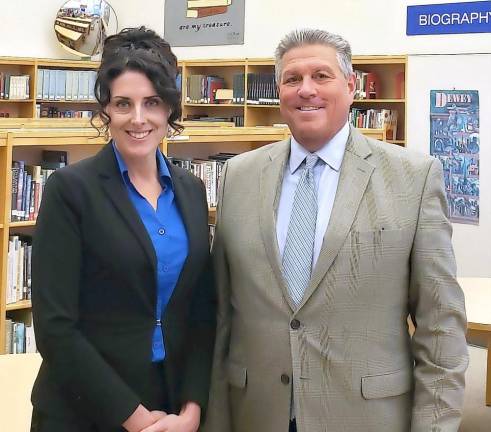Chester Schools Superintendent Denis M. Petrilak retires
Petrilak had been superintendent for three years and principal of Chester Academy for five years. His letter to the board announcing his retirement emphasized his “people-centered” administration and adaptative strategies during the Covid-19 pandemic.

The retirement of Chester School Superintendent Denis M. Petrilak was recently announced by Frank Sambets, President of the Chester UFSD Board of Education. He also announced the appointment of Catherine O’Hara as the next Chester Superintendent of Schools, effective July 1, 2022.
Mr. Petrilak served the last three years as superintendent of schools and previously spent five years as principal of Chester Academy.
In his letter to the Board of Education Mr. Petrilak wrote, “I am proud of my contributions towards elevating the academic program in the School District, most recently in the development of a pre-kindergarten program, and notably in the area of STEM education.”
In Chester, STEM education, with hands-on learning, starts at preschool and continues through 12th grade.
“Our challenge is to help students become creative and innovative thinkers that can use technology to find solutions to real-world problems,” Petrilak said. “It starts with thinking; when you have creative and innovative thinkers they can use tech as a tool.”
The district’s universal pre-kindergarten program received funding from Senator Mike Skoufis.
“We have children reading who are not even in kindergarten yet; that opens up great potential for their future learning,” Petrilak said.
Chester also has a workplace learning program with internships in local companies and organizations. “It’s been tremendously successful,” Petrilak added, “with over 40 students involved out of a senior class of 93.”
Managing during the Covid pandemic and dealing with “incomplete, inconsistent, and always-changing information was a challenge,” Petrilak said, given the need to make sure students, staff and essential workers were safe.
Petrilak said he was “proud of fostering a people-centered school and district and providing many supports for students,” including counseling, an especially important feature in dealing with the educational disruptions and emotional toll from Covid.
Petrilak has a 37-year career in education. He received his B.A. in English from SUNY Buffalo and his M.S. in Education from Iona College. Before coming to Chester, he spent 14 years at George F. Baker High School in Tuxedo, first as Assistant Principal and then as Principal.
Petrilak and his wife Eileen will be moving to Florida. He plans to spend more time with family and travel. “I still feel I have a lot to offer,” he said, “I will spend time volunteering in the community and stay involved in public education at some level.”
XXXXXXXXXXXXXXXXXXXXXXXXXXXXXXXXXXXXXXXXXXXXXXXXXXXXXXXXXXXXXXXX
Cathy O’Hara appointed as new Chester Schools Superintendent, effective July 1.
By Ginny Privitar
Incoming Chester Schools Superintendent Cathy O’Hara has a 19-year history with the district. O’Hara has served as an academic support specialist, classroom teacher with experience in Pre-K, middle and high school, and special education. Her leadership roles include district STEM coordinator, elementary school principal and, most recently, assistant superintendent of schools.
She received her Bachelor of Science in Industrial Engineering and Management from Clarkson University and a Master of Education degree from St. Michael’s College.
Her engineering background led the district to name her STEM coordinator to provide students with real world applications, solving problems in science, technology, engineering and math.
“Instead of just learning from a text book, education should be “meaningful to students and allow them to see how learning applies to real-world problems or careers,” O’Hara said.
O’Hara stresses the value of reaching out to all stakeholders for input and feedback and using that feedback to improve. As principal, she was proud of her success in building a collaborative team with staff, teachers and parents during Covid.
“How do we engage our students remotely and in person despite the challenges and constraints of the pandemic?” she asked. One strategy mentioned was to provide children with their own bin of manipulatives for math, since they couldn’t share materials during Covid.
Another pandemic adaptation was a collaborative lesson by art teacher Emily Daunicht and music teacher Brandon Sparkman. Students researched and built 3D models of New York State birds, used a touch board to program the sounds of the birds, and wrote information texts about each. They learned about different types of microphones and recorded the texts they had written. When touched on different parts, the models would make a sound or tell you something about the bird in the interactive displays students created.
In an example of real-world application, student teams built robotic Ferris wheels. It provided an opportunity for students to apply skills in several areas including research, using math and precise measurements and critical thinking. Teams worked collaboratively and brainstormed how to build and improve their designs, providing their own solutions.
O’Hara recognizes the importance of being proactive with technology to prepare for “the ever-changing careers and job skills required of our students.” With advances in technology, “we can provide opportunities that balance preparing students for those technological advancements and skills coupled with the soft skills of communication, collaboration, critical thinking and creativity,” O’Hara said. “And add the interpersonal skills: honesty, trust, empathy and kindness. We need to insure we educate the whole learner.”
O’Hara has four main goals for the district:
1. Ensure a welcoming and affirming environment for all; all students, staff, parents and community members,
representative of integrity, mutual respect and kindness.
2. Provide students with innovative, engaging learning experiences reflective of authentic, real-world applications.
3. Foster learning opportunities that promote critical thinking, collaboration, creativity and communication.
4. Ensure continuous improvement in students’ learning through collaborative partnerships with all stakeholders.